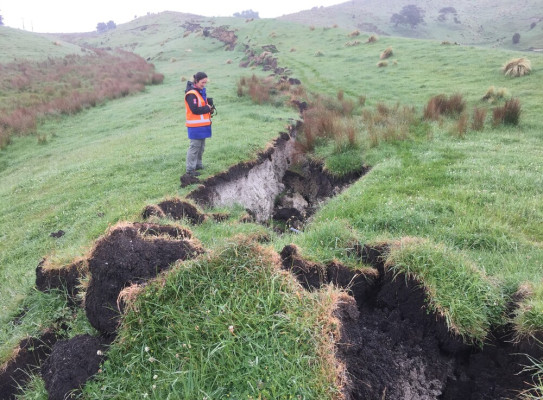Advancing science today is preparing tomorrow’s solutions

A new study suggests New Zealand’s existing GeoNet sensor network has the potential to support actionable earthquake early warnings (EEW) for the largest earthquakes.
The study(external link) found GeoNet’s network paired with FinDer – a rupture detection tool adapted for New Zealand through the Rapid Characterisation of Earthquake and Tsunami programme – could provide the underpinning capability for early warnings tens of seconds ahead of a large earthquake in areas distant to the epicentre.
For early warning alerts to reach New Zealanders, development of a sustainable operational EEW system and integration with national warning systems would be required.
Studies show that even just a few seconds of warning is enough time to take some protective action, such as finding a safe place to drop, cover and hold, a driver pulling over their car or stopping a potentially hazardous activity, such as working with chemicals or getting down from a ladder to prevent a fall.
Earth Sciences New Zealand seismologist and lead author of the study, Jen Andrews, says the technical capability to detect earthquakes in time to deliver early warnings is just one piece of the pipeline needed for an effective early warning system – but a critical one.
This is part of our ongoing innovative research programme to ensure the science is advanced and available, if and when it is needed, to support decision-makers realise a safer tomorrow.
FinDer is used elsewhere in the world to support earthquake early warnings, including the United States and Central America. Adapting it for New Zealand’s complex tectonic setting is a significant achievement and brings Aotearoa closer to being able to adopt its use locally.
“Our study shows that, with the FinDer tool, the current GeoNet sensors and their distribution could technically provide early warning for large earthquakes of magnitude 7 or greater.
“Importantly however, those closest to the earthquake epicentre would not receive a warning. Knowing what to do once shaking begins is the best way for people to safeguard their lives and livelihoods.”
Dr Andrews says more work would be needed to explore how a warning system could be operationalised to ensure a reliable and cost-effective system was feasible.
“Perhaps most importantly, the effectiveness of an EEW relies most on people knowing the appropriate action to take once an alert is received.”
The merging of GNS Science, NIWA and MetService into Earth Sciences New Zealand creates a powerhouse of natural hazard data and expertise. It affords an exciting opportunity to deliver a joined-up approach, improving how multi-hazard monitoring data and science advice are provided to emergency managers to support optimum public safety.

-
Key study findings
- Using the Kaikōura 2016 (magnitude 7.8) as a case study, while those within 20 kms of the epicentre would not receive an alert in time, most locations (including the top of the South Island and Wellington) with moderate to strong shaking (MMI 5 – 7) would receive alerts from several seconds up to two minutes.
- False alerts should not be a significant problem. However, because large earthquakes take time to evolve, for people to receive as much warning time as possible, alerts would need to be sent for earthquakes with a ground shaking intensity of MMI 4 and above, regardless of whether the earthquake evolves into a larger more damaging event.
- Based on earthquakes over the past two years, this would mean that over that time one alert would have been received by 1.3 million people up to seven alerts by 1,000 people.
- For moderate earthquakes (magnitude 6 – 7), the current system may only be able to provide useful warnings of only a few seconds for a minority of strongly shaken sites away from the epicentre.
